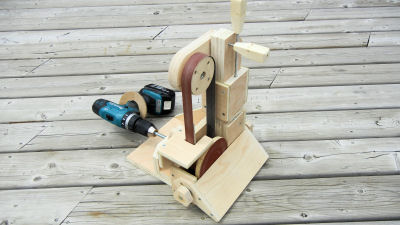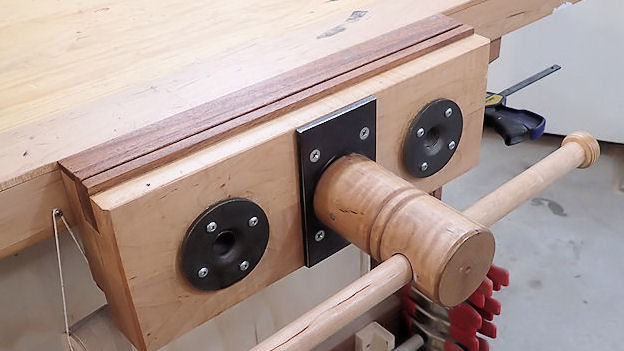Making A Deck Chair General Woodworking
The design for this chair was something I came up with years ago. At the time, I made these (and a few other similar items) to sell and they were fairly popular and easy to make quickly.
That was more than twenty year ago and since then I’ve lost the details on how I built the chair. Since I think it’s a design that is well worth sharing, I dug into my (fading) memory and was able to work up a usable plan. Back when I made these, I didn’t even write the measurements down in a “real” plan, because after making a couple, I could easily remember all of the angles and dimensions. Boy, that has certainly changed!
The chair is simple and has an economy of design that I appreciate. It uses very little lumber and doesn’t require any fancy tools to construct. The fasteners are cheap, just galvanized (not electroplated) 2″ nails and lag bolts. Glue is optional, but recommended as it serves to seal the joints against water entry, as well as adding strength. I’m making mine from cedar, but any type of wood can be used.
Unlike an Adirondack style chair, this one is more upright and is perfect at a table to eat meals. It is also
very comfortable for just sitting, having a drink and relaxing.
The materials needed for one chair, with some lumber to spare for the inevitable mistakes:
2 – 2x4x10′ cedar, spruce, pressure treated
1 – 2x6x8′ same wood as the 2×4’s
3 – 1x6x6′ fence boards to match
4 – 6″ x 3/8″ lag bolts with washers
2 – 3″ x 5/16″ lag bolts with washers
A quantity of 2″ galvanized ardox nails
Glue. I used polyurethane construction adhesive.
Just basic tools are needed, circular saw, jigsaw, drill / driver and a hammer.
To easily make the various angled cuts with the circular saw, I made this cutting guide:
.jpg)
The angle is adjustable through a wide range and is very accurate. For more detail on this, I have a full write-up here.
The starting point is arbitrary, as all of the parts need to be cut before assembly can begin. I chose to do the back supports first. These are cut on an angle at the bottom and taper up to the top:
.jpg)
.jpg)
Next I cut the back legs. These have a fairly sharp angle cut at the bottom and two angle cuts at the front.
The seat supports make up the third part of the frame and have another sharp angle cut. Back when I was making these chairs to sell, I used to make these cuts freehand on the table saw, since they were impossible to do on the miter saw I had at that time:
.jpg)
.jpg)
The armrests are cut from 2×6 and are a bit more complex.
The front legs are next and they need an 85 degree cut on the bottom. I set the saw to 5 degrees and made the cut:
.jpg)
.jpg)
These taper in 1-1/2″, 6″ from the top.
All of the slats are cut for the back of the chair. One problem I encountered was that I made the plan for 5-1/2″ wide boards, but these were closer to 5-1/4″, so the spacing had to be adjusted:
.jpg)
.jpg)
The slats for the seat are cut out as well.
The frame parts are checked to make sure the joints are tight before I start putting it together:
.jpg)
.jpg)
The seat support is attached to the back leg with glue, two nails and a screw.
The other two joints are glued and toenailed together to hold them in place until the lag bolts are driven:
.jpg)
.jpg)
A 5/16″ hole is drilled through the back leg and into the back support. To help lubricate the bolt while it’s being driven, some construction adhesive is pumped into the hole. This also adds a lot of strength and seals the bolt in the wood.
The 6″ lag bolt is driven in next. I could have used a shorter one and drilled a counterbore for it to fit in, but that will accelerate rot as it provides an entry point for water:
.jpg)
Where the back support meets the seat support another 6″ bolt is driven. There are other ways to secure these joints, but this is the most efficient and least obtrusive. Gussets would be a bulky alternative, as well as the very unsightly pocket screws.
With the basic frames assembled, the front legs can be attached. These are 90 degrees to the top of the seat support, and I’m using the cutting guide to mark the angle. Once marked, glue is spread in the contact area:
.jpg)
.jpg)
A clamp holds it while two screws are driven, and a 1/4″ hole is drilled:
.jpg)
.jpg)
A 3″ x 5/16″ lag bolt is driven in flush to the surface:
.jpg)
.jpg)
With both frames put together, I can get the slats installed. I’ve clamped the frames down to my work table and made them square and parallel to each other. The first board is nailed and glued on:
.jpg)
With the back done, I can put the chair on the ground and finish it:
.jpg)
.jpg)
The bottom slats need to go on before the armrests, as it would be very difficult to put the notched slat in around the front legs.
The armrests are screwed and glued to the top of the front legs:
.jpg)
.jpg)
And to the back supports.
Finished:
.jpg)
All I need now is to make a few more, but first I need a deck to put them on!
I made a short video of the build from beginning to end, and it actually goes into a bit more detail than I did in this article:















